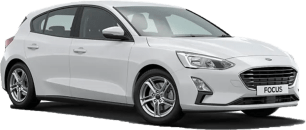The interior of the Skoda Octavia RS is considerably different to the models that have come before it - it seemingly walks its own line now, rather than following on from VW products like the last models seemed to.
As such, it feels more technologically advanced and more high tech than you might expect, and admittedly, some customers mightn’t love the way things have been reworked inside the car. But hey, you still get an umbrella in the driver’s door, so don’t go whinging too much.
That’s because there is a large 10.0-inch touchscreen media system which doesn’t just control your AM/FM/DAB radio, Bluetooth phone and audio, and wireless or cord-connect USB Apple CarPlay and Android Auto, it also is the interface with the HVAC system.
So rather than having distinct knobs and dials to control the air conditioning, heating, recirculation and so on, you have to operate those through the screen. I’ve hated this in cars I’ve sampled it in before, and it’s still not my favourite means of air management.
At the very least there’s a home-key section at the bottom of the screen to make quick adjustments to temperatures (and seat heating if fitted), but you still need to go into the “Clima” menu to adjust fan settings, while there is a tablet-style drop-down at the top of the screen to allow a quick change to recirculation air (not as quick as a single button press would be, however!).
The air-con system also has a “modern” way for adjusting the temp, like “cool my hands” or “warm my feet”, which I think is lame. Thankfully there are classic controls with conventional icons.
What isn’t conventional is the volume controller, which isn’t a knob but rather is a touch-slider. It took me about two seconds to get used to and it’s not too sensitive. Those touch-slide controls are also included if you option the sunroof in the wagon.
Then there’s the Virtual Cockpit digital screen, which is configurable to a degree and allows you easy access to clear instrumentation via the steering wheel controls (which are new and different and take a little bit of getting used to). Premium Pack models also get the head-up display (HUD) which just means you’ve got to look away from the road less.
The dashboard design is neat and the materials are of a high quality, and the storage options are mostly really good, too. There are large door pockets for bottles and other loose items (and you get those clever little Skoda bins in there, too), and a large storage section in front of the gear selector with a wireless phone charger, too. There are cup holders in between the seats, but they’re not very accommodating for larger drinks, and the covered centre console bin isn’t huge, either.
In the back there are also large door pockets, map pockets on the seat backs and a flip-down armrest with cupholders (again, not massive ones).
The space in the second row is adequate for someone my size (182cm / 6’0”) to sit behind their own driving position, but anyone taller might find it a bit too squeezy. The front sports seats are large and a bit bulky so they eat into rear space a tad. That said, I had enough knee, toe and head room (but the panoramic sunroof does eat into headspace a touch).
If your passengers are smaller, there are dual ISOFIX and three top-tether child seat attachment points. And the amenities are good, too, with rear seat directional air vents and USB-C ports in the back (x2), plus if you get the Premium Pack you’ll also get rear seat heating and climate controls for the back, too.
The boot capacity is excellent for luggage space, with the liftback sedan model offering 600 litres of cargo capacity, and that increases to 640L in the wagon. Fold down the rear seats using the levers in the rear, and you get up to 1555L in the sedan and 1700L in the wagon. Huge! Plus there are all the Skoda nets and mesh holsters, a clever multi-stage cargo blind, side storage compartments, a reversible floor mat (perfect for muddy clothes or damp dogs!) and there’s a space-saver spare wheel under the boot floor as well.







































































